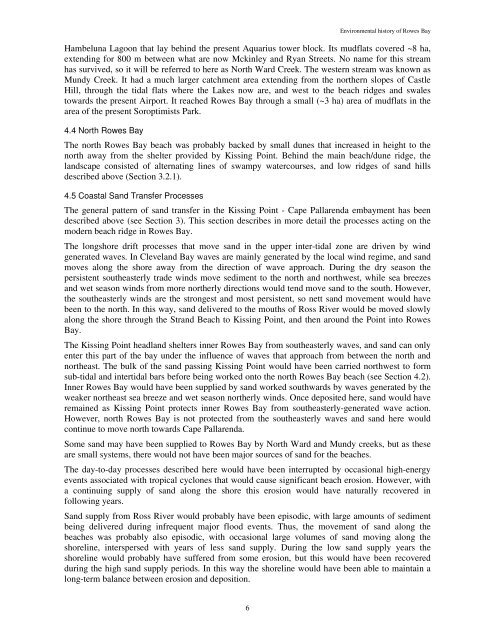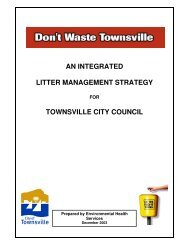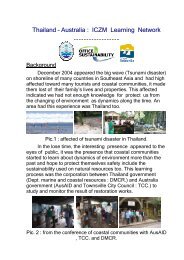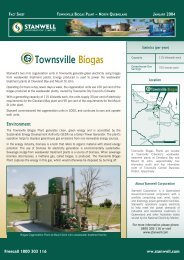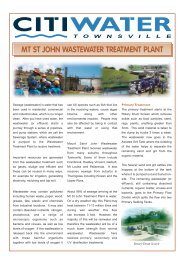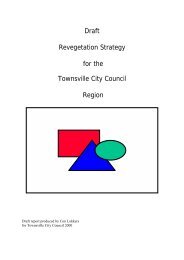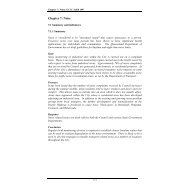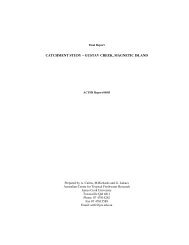ENVI RONMENTAL HI STORY OF ROWES BAY - Townsville State ...
ENVI RONMENTAL HI STORY OF ROWES BAY - Townsville State ...
ENVI RONMENTAL HI STORY OF ROWES BAY - Townsville State ...
- No tags were found...
You also want an ePaper? Increase the reach of your titles
YUMPU automatically turns print PDFs into web optimized ePapers that Google loves.
Environmental history of Rowes BayHambeluna Lagoon that lay behind the present Aquarius tower block. Its mudflats covered ~8 ha,extending for 800 m between what are now Mckinley and Ryan Streets. No name for this streamhas survived, so it will be referred to here as North Ward Creek. The western stream was known asMundy Creek. It had a much larger catchment area extending from the northern slopes of CastleHill, through the tidal flats where the Lakes now are, and west to the beach ridges and swalestowards the present Airport. It reached Rowes Bay through a small (~3 ha) area of mudflats in thearea of the present Soroptimists Park.4.4 North Rowes BayThe north Rowes Bay beach was probably backed by small dunes that increased in height to thenorth away from the shelter provided by Kissing Point. Behind the main beach/dune ridge, thelandscape consisted of alternating lines of swampy watercourses, and low ridges of sand hillsdescribed above (Section 3.2.1).4.5 Coastal Sand Transfer ProcessesThe general pattern of sand transfer in the Kissing Point - Cape Pallarenda embayment has beendescribed above (see Section 3). This section describes in more detail the processes acting on themodern beach ridge in Rowes Bay.The longshore drift processes that move sand in the upper inter-tidal zone are driven by windgenerated waves. In Cleveland Bay waves are mainly generated by the local wind regime, and sandmoves along the shore away from the direction of wave approach. During the dry season thepersistent southeasterly trade winds move sediment to the north and northwest, while sea breezesand wet season winds from more northerly directions would tend move sand to the south. However,the southeasterly winds are the strongest and most persistent, so nett sand movement would havebeen to the north. In this way, sand delivered to the mouths of Ross River would be moved slowlyalong the shore through the Strand Beach to Kissing Point, and then around the Point into RowesBay.The Kissing Point headland shelters inner Rowes Bay from southeasterly waves, and sand can onlyenter this part of the bay under the influence of waves that approach from between the north andnortheast. The bulk of the sand passing Kissing Point would have been carried northwest to formsub-tidal and intertidal bars before being worked onto the north Rowes Bay beach (see Section 4.2).Inner Rowes Bay would have been supplied by sand worked southwards by waves generated by theweaker northeast sea breeze and wet season northerly winds. Once deposited here, sand would haveremained as Kissing Point protects inner Rowes Bay from southeasterly-generated wave action.However, north Rowes Bay is not protected from the southeasterly waves and sand here wouldcontinue to move north towards Cape Pallarenda.Some sand may have been supplied to Rowes Bay by North Ward and Mundy creeks, but as theseare small systems, there would not have been major sources of sand for the beaches.The day-to-day processes described here would have been interrupted by occasional high-energyevents associated with tropical cyclones that would cause significant beach erosion. However, witha continuing supply of sand along the shore this erosion would have naturally recovered infollowing years.Sand supply from Ross River would probably have been episodic, with large amounts of sedimentbeing delivered during infrequent major flood events. Thus, the movement of sand along thebeaches was probably also episodic, with occasional large volumes of sand moving along theshoreline, interspersed with years of less sand supply. During the low sand supply years theshoreline would probably have suffered from some erosion, but this would have been recoveredduring the high sand supply periods. In this way the shoreline would have been able to maintain along-term balance between erosion and deposition.6


